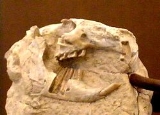
Palaeolagus
Encyclopedia
Palaeolagus is an extinct genus of lagomorph. Palaeolagus lived in the Oligocene
period which was about 33-23 million years ago. The earliest leporids described from the fossil record of North America and Asia date to the upper Eocene
some 40 million years ago. Selective pressure ostensibly drove them to become ever faster and better at running and jumping. Other fossil finds from Asia indicate more primitive progenitors of Palaeolagus existed in the lower Eocene; this pushes the likely date of divergence of rabbit-like and rodent-like lagomorphs back to more than 50 million years ago.
The 25 centimetres (9.8 in) long creature closely resembled modern rabbit
s. However, it had shorter hind limbs than living rabbits, suggesting that it was probably unable to hop, and would have instead moved in a creeping fashion similar to a ground squirrel
. They were common herbivorous inhabitants of the savanna, plains and woodlands of North America 30 million years ago.
The fossil remains of rabbits are scanty and those specimens that have been found are often too fragmentary to determine satisfactory the relationship with living forms. The bones of rabbits and hares are lightweight and fragile in structure, and so they are not easily preserved as fossils. Most of the species are inhabitants of uplands where conditions are not ideal for preservation. In a few deposits, rabbit remains seem numerous but many fossil species are known only from a few teeth and bones.
Oligocene
The Oligocene is a geologic epoch of the Paleogene Period and extends from about 34 million to 23 million years before the present . As with other older geologic periods, the rock beds that define the period are well identified but the exact dates of the start and end of the period are slightly...
period which was about 33-23 million years ago. The earliest leporids described from the fossil record of North America and Asia date to the upper Eocene
Eocene
The Eocene Epoch, lasting from about 56 to 34 million years ago , is a major division of the geologic timescale and the second epoch of the Paleogene Period in the Cenozoic Era. The Eocene spans the time from the end of the Palaeocene Epoch to the beginning of the Oligocene Epoch. The start of the...
some 40 million years ago. Selective pressure ostensibly drove them to become ever faster and better at running and jumping. Other fossil finds from Asia indicate more primitive progenitors of Palaeolagus existed in the lower Eocene; this pushes the likely date of divergence of rabbit-like and rodent-like lagomorphs back to more than 50 million years ago.
The 25 centimetres (9.8 in) long creature closely resembled modern rabbit
Rabbit
Rabbits are small mammals in the family Leporidae of the order Lagomorpha, found in several parts of the world...
s. However, it had shorter hind limbs than living rabbits, suggesting that it was probably unable to hop, and would have instead moved in a creeping fashion similar to a ground squirrel
Ground squirrel
The ground squirrels are members of the squirrel family of rodents which generally live on or in the ground, rather than trees. The term is most often used for the medium-sized ground squirrels, as the larger ones are more commonly known as marmots or prairie dogs, while the smaller and less...
. They were common herbivorous inhabitants of the savanna, plains and woodlands of North America 30 million years ago.
The fossil remains of rabbits are scanty and those specimens that have been found are often too fragmentary to determine satisfactory the relationship with living forms. The bones of rabbits and hares are lightweight and fragile in structure, and so they are not easily preserved as fossils. Most of the species are inhabitants of uplands where conditions are not ideal for preservation. In a few deposits, rabbit remains seem numerous but many fossil species are known only from a few teeth and bones.

